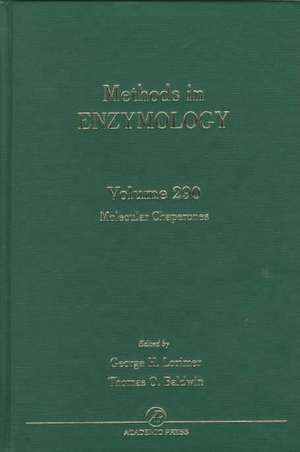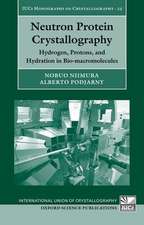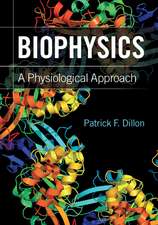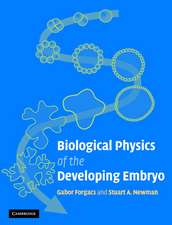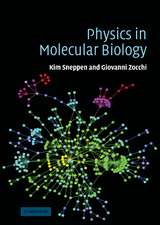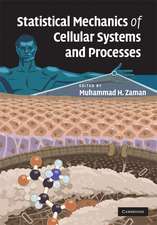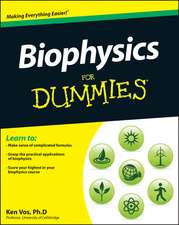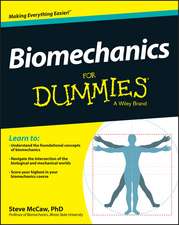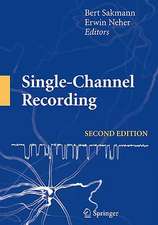Molecular Chaperones: Methods in Enzymology, cartea 290
John N. Abelson, Melvin I. Simon George H. Lorimer, Thomas O. Baldwinen Limba Engleză Hardback – 17 apr 1998
- Catalysts of Protein Folding: Protein Disulfide Isomerases, Cis-trans Peptidyl Prolyl Isomerases
- Accessory Proteins: Chaperonins, Cochaperonins, Pap Proteins, Sec Proteins
- Physical methods for investigation of interactions between chaperones and their substances
- Cotranslational protein folding, cell-free protein synthesis and associated methods
Din seria Methods in Enzymology
-
 Preț: 390.54 lei
Preț: 390.54 lei -
 Preț: 391.30 lei
Preț: 391.30 lei -
 Preț: 392.01 lei
Preț: 392.01 lei -
 Preț: 391.01 lei
Preț: 391.01 lei - 28%
 Preț: 801.23 lei
Preț: 801.23 lei - 32%
 Preț: 802.54 lei
Preț: 802.54 lei - 23%
 Preț: 461.36 lei
Preț: 461.36 lei - 23%
 Preț: 460.60 lei
Preț: 460.60 lei - 23%
 Preț: 439.86 lei
Preț: 439.86 lei - 23%
 Preț: 448.15 lei
Preț: 448.15 lei - 23%
 Preț: 451.42 lei
Preț: 451.42 lei - 23%
 Preț: 445.18 lei
Preț: 445.18 lei - 5%
 Preț: 557.15 lei
Preț: 557.15 lei - 23%
 Preț: 450.67 lei
Preț: 450.67 lei - 23%
 Preț: 446.23 lei
Preț: 446.23 lei - 23%
 Preț: 435.87 lei
Preț: 435.87 lei - 23%
 Preț: 445.94 lei
Preț: 445.94 lei - 23%
 Preț: 459.55 lei
Preț: 459.55 lei - 23%
 Preț: 460.02 lei
Preț: 460.02 lei - 23%
 Preț: 450.54 lei
Preț: 450.54 lei - 23%
 Preț: 453.47 lei
Preț: 453.47 lei - 5%
 Preț: 565.37 lei
Preț: 565.37 lei - 23%
 Preț: 450.67 lei
Preț: 450.67 lei - 23%
 Preț: 464.33 lei
Preț: 464.33 lei - 23%
 Preț: 441.49 lei
Preț: 441.49 lei - 23%
 Preț: 447.44 lei
Preț: 447.44 lei - 23%
 Preț: 459.13 lei
Preț: 459.13 lei - 23%
 Preț: 450.38 lei
Preț: 450.38 lei - 23%
 Preț: 445.80 lei
Preț: 445.80 lei - 23%
 Preț: 445.35 lei
Preț: 445.35 lei - 23%
 Preț: 442.53 lei
Preț: 442.53 lei - 23%
 Preț: 450.38 lei
Preț: 450.38 lei - 23%
 Preț: 448.60 lei
Preț: 448.60 lei - 23%
 Preț: 447.57 lei
Preț: 447.57 lei - 23%
 Preț: 440.90 lei
Preț: 440.90 lei - 23%
 Preț: 448.15 lei
Preț: 448.15 lei - 23%
 Preț: 466.84 lei
Preț: 466.84 lei - 23%
 Preț: 451.42 lei
Preț: 451.42 lei - 23%
 Preț: 453.64 lei
Preț: 453.64 lei - 23%
 Preț: 459.13 lei
Preț: 459.13 lei - 23%
 Preț: 457.49 lei
Preț: 457.49 lei - 23%
 Preț: 447.44 lei
Preț: 447.44 lei - 5%
 Preț: 561.34 lei
Preț: 561.34 lei - 23%
 Preț: 447.57 lei
Preț: 447.57 lei - 23%
 Preț: 453.35 lei
Preț: 453.35 lei - 23%
 Preț: 441.95 lei
Preț: 441.95 lei - 23%
 Preț: 450.38 lei
Preț: 450.38 lei - 23%
 Preț: 449.19 lei
Preț: 449.19 lei - 23%
 Preț: 456.02 lei
Preț: 456.02 lei
Preț: 1162.27 lei
Preț vechi: 1592.15 lei
-27% Nou
Puncte Express: 1743
Preț estimativ în valută:
222.47€ • 241.73$ • 186.100£
222.47€ • 241.73$ • 186.100£
Carte tipărită la comandă
Livrare economică 22 aprilie-06 mai
Preluare comenzi: 021 569.72.76
Specificații
ISBN-13: 9780121821913
ISBN-10: 0121821919
Pagini: 500
Dimensiuni: 152 x 229 x 30 mm
Greutate: 0.88 kg
Editura: ELSEVIER SCIENCE
Seria Methods in Enzymology
ISBN-10: 0121821919
Pagini: 500
Dimensiuni: 152 x 229 x 30 mm
Greutate: 0.88 kg
Editura: ELSEVIER SCIENCE
Seria Methods in Enzymology
Public țintă
AUDIENCE: Biochemists, cell biologists, molecular biologists, biophysicists, microbiologists, plant scientists, and geneticists.Cuprins
A.N. Fedorov and T.O. Baldwin, Protein Folding and Assembly in a Cell-Free Expression System.
B.A. Hardesty, G. Kramer, T. Zhang, and W. Kudlicki, Preparation and Application of Chaperone-Deficient Escherichia coli Cell-free Translation Systems.
H.F. Gilbert, V. McLean, and M. McLean, Protein Disulfide Isomerase.
Y. Yamada, S. Udaka, T. Kajino, C. Miyazaki, O. Asami, and M. Hirai, Thermophilic Fungal Protein Disulfide Isomerase.
J.C.A. Bardwell and T. Zander, Disulfide Bond Catalysts in Escherichia coli.
J.J. Siekierka and G. Wiederrecht, Yeast Immunophilins: Purification and Assay of Yeast FKBP12.
A.K. Matoo, Peptidylprolyl cis-trans-isomerases from Plant Organelles.
C. Frieden, A.C. Clark, and R. Ramanathan, Purification of GroEL with Low Fluorescence Background.
M. Fisher, E. Eisenstein, and P. Reddy, Overexpression, Purification, and Properties of GroES for Escherichia coli.
M.J. Todd and G.H. Lorimer, Criteria for Assessing the Purity and Quality of GroEL.
A.L. Horwich, S.G. Burston, H.S. Rye, J.S. Weissman, and W.A. Fenton, Construction of Single-Ring and Two-Ring Hybrid Versions of Bacterial Chaperonin GroEL.
B.A. McFadden and J.A. Torres-Ruiz, Chaperonin 6014 and Co-Chaperonin 107 from Chromatium vinosum.
F.R. Tabita, W.T. Lee, and G.M.F. Watson, Chaperonins of Purple Nonsulfur Bacterium Rhodobacter sphaeroides.
R.K. Scopes and K. Truscott, Chaperonins from Thermoanaerobacter Species.
M. Yoshida and H. Taguchi, Chaperonin from a Thermophile, Thermus thermophilus.
M. Morioka and H. Ishikawa, Insect Chaperonin 60: Symbionin.
G. Schatz, Y. Dubaquié, and S. Rospert, Purification of Yeast Mitochondrial Chaperonin 60 and Co-Chaperonin 10.
P.V. Viitanen, G. Lorimer, W. Bergmeier, C. Weiss, M. Kessel, and P. Goloubinoff, Purification of Mammalian Mitochondrial Chaperonin 60 through in vitro Reconstitution of Active Oligomers.
P.V. Viitanen, K. Bacot, R. Dickson, and T. Webb, Purification of Recombinant Plant and Animal GroES Homologs: Chloroplast and Mitochondrial Chaperonin 10.
N.J. Cowan, Mammalian Cytosolic Chaperonin.
H.R. Saibil, S. Chen, and A.M. Roseman, Electron Microscopy of Chaperonins.
P. Goloubinoff, A. Azem, and C. Weiss, Using Chemical Cross-linking Structural Analysis of GroE Chaperonin Complexes.
H-J. Schönfeld and J. Behlke, Molecular Chaperones and Their Interactions Investigated by Analytical Ultracentrifugation and Other Methodologies.
S.E. Radford, C.V. Robinson, and M. Gross, Probing Conformation of GroEL-Bound Substrate Proteins by Mass Spectrometry.
P.M. Horowitz and B.M. Gorovits, Fluorescence Anisotropy Method for Investigation of GroEL-GroES Interaction.
J.W. Seale, B.T. Brazil, and P.M. Horowitz, Photoincorporation of Fluorescent Probe into GroEL: Defining Site of Interaction.
J. Buchner, H. Grallert, and U. Jakob, Analysis of Chaperone Function Using Citrate Synthase as Nonnative Substrate Protein.
J. Buchner, M. Ehrnsperger, M. Gaestel, and S. Walke, Purification and Characterization of Small Heat Shock Proteins.
G.J. Lee and E. Vierling, Expression, Purification, and Molecular Chaperone Activity Plant Recombinant Small Heat Shock Proteins.
J. Horwitz, Q-L. Huang, L. Ding, and M.P. Bova, Lens a-Crystallin: Chaperone-like Properties.
S. Blond, M. Chevalier, and L. King, Purification and Properties of BiP.
J. Buchner, S. Bose, and U. Jakob, Purification and Characterization of Prokaryotic and Eukaryotic Hsp 90.
J. Buchner, T. Weikl, H. Bügl, F. Pirkl, and S. Bose, Purification of Hsp90 Partner Proteins Hop/p60, p23, and FKBP52.
S. Lindquist and E.C. Schirmer, Purification and Properties of Hsp104 from Yeast.
L.L. Randall, T.B. Topping, V.F. Smith, D.L. Diamond, and S.J.S. Hardy, SecB: A Chaperone from Escherichia coli.
Author Index.
Subject Index.
B.A. Hardesty, G. Kramer, T. Zhang, and W. Kudlicki, Preparation and Application of Chaperone-Deficient Escherichia coli Cell-free Translation Systems.
H.F. Gilbert, V. McLean, and M. McLean, Protein Disulfide Isomerase.
Y. Yamada, S. Udaka, T. Kajino, C. Miyazaki, O. Asami, and M. Hirai, Thermophilic Fungal Protein Disulfide Isomerase.
J.C.A. Bardwell and T. Zander, Disulfide Bond Catalysts in Escherichia coli.
J.J. Siekierka and G. Wiederrecht, Yeast Immunophilins: Purification and Assay of Yeast FKBP12.
A.K. Matoo, Peptidylprolyl cis-trans-isomerases from Plant Organelles.
C. Frieden, A.C. Clark, and R. Ramanathan, Purification of GroEL with Low Fluorescence Background.
M. Fisher, E. Eisenstein, and P. Reddy, Overexpression, Purification, and Properties of GroES for Escherichia coli.
M.J. Todd and G.H. Lorimer, Criteria for Assessing the Purity and Quality of GroEL.
A.L. Horwich, S.G. Burston, H.S. Rye, J.S. Weissman, and W.A. Fenton, Construction of Single-Ring and Two-Ring Hybrid Versions of Bacterial Chaperonin GroEL.
B.A. McFadden and J.A. Torres-Ruiz, Chaperonin 6014 and Co-Chaperonin 107 from Chromatium vinosum.
F.R. Tabita, W.T. Lee, and G.M.F. Watson, Chaperonins of Purple Nonsulfur Bacterium Rhodobacter sphaeroides.
R.K. Scopes and K. Truscott, Chaperonins from Thermoanaerobacter Species.
M. Yoshida and H. Taguchi, Chaperonin from a Thermophile, Thermus thermophilus.
M. Morioka and H. Ishikawa, Insect Chaperonin 60: Symbionin.
G. Schatz, Y. Dubaquié, and S. Rospert, Purification of Yeast Mitochondrial Chaperonin 60 and Co-Chaperonin 10.
P.V. Viitanen, G. Lorimer, W. Bergmeier, C. Weiss, M. Kessel, and P. Goloubinoff, Purification of Mammalian Mitochondrial Chaperonin 60 through in vitro Reconstitution of Active Oligomers.
P.V. Viitanen, K. Bacot, R. Dickson, and T. Webb, Purification of Recombinant Plant and Animal GroES Homologs: Chloroplast and Mitochondrial Chaperonin 10.
N.J. Cowan, Mammalian Cytosolic Chaperonin.
H.R. Saibil, S. Chen, and A.M. Roseman, Electron Microscopy of Chaperonins.
P. Goloubinoff, A. Azem, and C. Weiss, Using Chemical Cross-linking Structural Analysis of GroE Chaperonin Complexes.
H-J. Schönfeld and J. Behlke, Molecular Chaperones and Their Interactions Investigated by Analytical Ultracentrifugation and Other Methodologies.
S.E. Radford, C.V. Robinson, and M. Gross, Probing Conformation of GroEL-Bound Substrate Proteins by Mass Spectrometry.
P.M. Horowitz and B.M. Gorovits, Fluorescence Anisotropy Method for Investigation of GroEL-GroES Interaction.
J.W. Seale, B.T. Brazil, and P.M. Horowitz, Photoincorporation of Fluorescent Probe into GroEL: Defining Site of Interaction.
J. Buchner, H. Grallert, and U. Jakob, Analysis of Chaperone Function Using Citrate Synthase as Nonnative Substrate Protein.
J. Buchner, M. Ehrnsperger, M. Gaestel, and S. Walke, Purification and Characterization of Small Heat Shock Proteins.
G.J. Lee and E. Vierling, Expression, Purification, and Molecular Chaperone Activity Plant Recombinant Small Heat Shock Proteins.
J. Horwitz, Q-L. Huang, L. Ding, and M.P. Bova, Lens a-Crystallin: Chaperone-like Properties.
S. Blond, M. Chevalier, and L. King, Purification and Properties of BiP.
J. Buchner, S. Bose, and U. Jakob, Purification and Characterization of Prokaryotic and Eukaryotic Hsp 90.
J. Buchner, T. Weikl, H. Bügl, F. Pirkl, and S. Bose, Purification of Hsp90 Partner Proteins Hop/p60, p23, and FKBP52.
S. Lindquist and E.C. Schirmer, Purification and Properties of Hsp104 from Yeast.
L.L. Randall, T.B. Topping, V.F. Smith, D.L. Diamond, and S.J.S. Hardy, SecB: A Chaperone from Escherichia coli.
Author Index.
Subject Index.
Recenzii
Praise for the Series:
"The Methods in Enzymology series represents the gold-standard." --NEUROSCIENCE
"Incomparably useful." --ANALYTICAL BIOCHEMISTRY
"It is a true 'methods' series, including almost every detail from basic theory to sources of equipment and reagents, with timely documentation provided on each page." --BIO/TECHNOLOGY
"The series has been following the growing, changing and creation of new areas of science. It should be on the shelves of all libraries in the world as a whole collection." --CHEMISTRY IN INDUSTRY
"The appearance of another volume in that excellent series, Methods in Enzymology, is always a cause for appreciation for those who wish to successfully carry out a particular technique or prepare an enzyme or metabolic intermediate without the tiresome prospect of searching through unfamiliar literature and perhaps selecting an unproven method which is not easily reproduced." --AMERICAN SOCIETY OF MICROBIOLOGY NEWS
"If we had some way to find the work most often consulted in the laboratory, it could well be the multi-volume series Methods in Enzymology...a great work." --ENZYMOLOGIA
"A series that has established itself as a definitive reference for biochemists." --JOURNAL OF CHROMATOGRAPHY
"The Methods in Enzymology series represents the gold-standard." --NEUROSCIENCE
"Incomparably useful." --ANALYTICAL BIOCHEMISTRY
"It is a true 'methods' series, including almost every detail from basic theory to sources of equipment and reagents, with timely documentation provided on each page." --BIO/TECHNOLOGY
"The series has been following the growing, changing and creation of new areas of science. It should be on the shelves of all libraries in the world as a whole collection." --CHEMISTRY IN INDUSTRY
"The appearance of another volume in that excellent series, Methods in Enzymology, is always a cause for appreciation for those who wish to successfully carry out a particular technique or prepare an enzyme or metabolic intermediate without the tiresome prospect of searching through unfamiliar literature and perhaps selecting an unproven method which is not easily reproduced." --AMERICAN SOCIETY OF MICROBIOLOGY NEWS
"If we had some way to find the work most often consulted in the laboratory, it could well be the multi-volume series Methods in Enzymology...a great work." --ENZYMOLOGIA
"A series that has established itself as a definitive reference for biochemists." --JOURNAL OF CHROMATOGRAPHY
